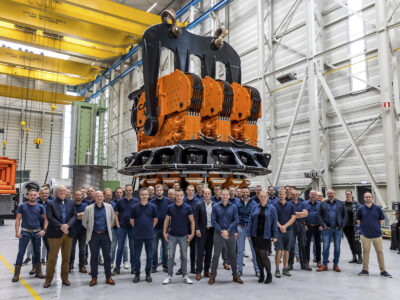
Anchor pile installation
ANCHOR PILE INSTALLATION
Anchor piles have been around for a long time to securely hold offshore floaters in place for the oil and gas industry. Compared to other anchoring solutions, such as drag embedded anchors, piles bring various benefits as they can transfer high loads not only horizontally, but also vertically and in multiple directions.
It allows mooring of any floating structure design, such as Semi-Subs, SPARs, FPSOs and TLPs with the smallest footprint possible and therefore also ideal for floating structures for renewable energy. As piles can be loaded in all directions, they are the ultimate anchoring solutions for projects that require a grid anchoring system like floating offshore wind farms.
KEEPING PILE VERTICAL
DURING DRIVING
With the traditional installation method of driving anchor piles with an impact hammer, a support frame needs to be placed on the seabed to keep the pile from falling over and to keep it vertical during driving. These frames are generally very big and heavy to make sure they can withstand the lateral forces of the pile with an impact hammer on top. They often also require large mud mats to maintain the pile level during driving. Due to their size, they take up large deck space, limiting the number of piles and other parts required for the installation. The frames require a levelling system to assure verticality. The size of such frames makes it difficult to drive piles near to other structures or very uneven sea beds.
THE SOLUTION
With the CAPE VLT it is possible to upend the anchor pile, lift it to the position where the anchor lines are connected to the pad eyes after which the pile is lowered to the installation position where it can be driven free hanging from the crane in any seabed, even sloped or very uneven. The anchor lines can be manipulated by tugger lines from the installation vessel or from support vessels to ensure the required orientation. The verticality can be corrected with the crane or position of the vessel. As the pile is held via the CAPE VLT in the crane, it can not fall over during the installation as gravity helps to keep it straight.
STUCK FOLLOWER
It is common practice in many locations for anchor piles to be driven to below the seabed to prevent scour. This can only be achieved by the use of a follower with an impact hammer. This follower transfers the energy of the impact hammer through a steel pipe to the anchor pile. Sometimes these piles are driven 4 to 6m below the seabed which means the follower can get stuck in the top of the pile due to the soil between pile and follower and due to the soil resistance of the layers in which the follower is penetrated. Quite often the available crane does not have sufficient capacity to safely pull the follower from the soil.
THE SOLUTION
The CAPE VLT can be stabbed onto the follower to safely and easily extract the follower. If the CAPE VLT is used to drive the piles initially to stability before the follower is required to drive the remaining part to below the sea bed with an impact hammer, the same CAPE VLT can also be used as a contingency for the extraction of a stuck follower without requiring any other additional tools.
PILE RUN
In many places in the world and particularly in locations with seismic activity there is a high risk of pile run. In China and Taiwan these risks have already shown that they should be taken seriously and in parts of US waters and even in the North Sea these risks should not be underestimated. The effects of a pile run can be severe in terms of likely damage to the vessel, pile and equipment as well as the likelihood of the pile being out of installation tolerance.
THE SOLUTION
With a fixed connection of the CAPE VLT to the crane and the pile to the CAPE VLT, it is not possible for the pile to go into free fall when hitting a very soft soil layer. This makes the CAPE VLT the only pile driving tool that mitigates the risk completely. The only condition is that the crane has sufficient capacity to carry the pile and the CAPE VLT together.
WHY USE THE CAPE VLT
FOR ANCHOR PILE INSTALLATION?
NO NEED FOR INSTALLATION FRAME
VERTICALITY DURING DRIVING
LOW NOISE EMISSIONS
UPENDING, LIFTING, DRIVING IN SINGLE OPERATION
EXTRACTION OF STUCK FOLLOWER
vibro
lifting
technology

Discover how its unique features will uplift your next project; download the vibro lifting technology guide.




